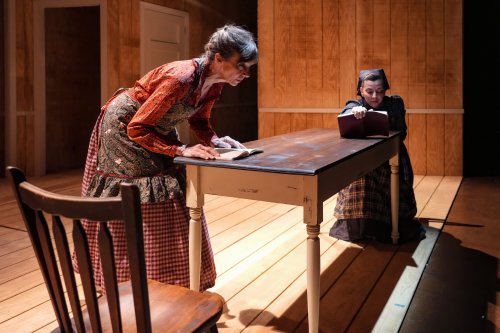Evelyn Brown (A Diary)
La MaMa presents a revival of a lost treasure conceived and originally directed by María Irene Fornés that is an homage to a New Hampshire domestic, circa 1909.

Ellen Lauren and Violeta Picayo in a scene from Maria Irene Fornés’ “Evelyn Brown (A Diary)” at The Downstairs Theater at La MaMa (Photo credit: Steven Pisano)
[avatar user=”Tony Marinelli” size=”96″ align=”left”] Tony Marinelli, Critic[/avatar]
The opening vignette of María Irene Fornés’ long lost Evelyn Brown (A Diary) finds actress Ellen Lauren as Evelyn, blindfolded, center stage, palms turned out, turning ever so slowly. And almost immediately we feel intuitively “what does she really have to see anyway when she is not wearing the blindfold?” When consulting the dictionary for the word “drudge,” Evelyn’s photo may very well be there in place of a definition. Nevertheless, “drudge” is defined as a person who does menial, distasteful, dull, or hard work. It is also defined as a person who works in a routine, unimaginative way.
We are made to feel the houses Evelyn drudges in (“drudges” now used as a verb) are completely devoid of any color or excitement. Evelyn’s diary entry each day begins with a nod to the weather…anywhere in New England in the winter months is going to be cold or damp or both. It’s meant for the type of person who can really toughen it out and is used to wearing layers upon layers just to stave off the chill.
There is always mention of the chores and just how much time is spent on tackling these chores: preparing the meals, washing the dishes, sweeping, dusting, washing of laundry, ironing and mending. We hear of the visits of people who come to pay a call, but only as a matter of fact… an event that has no point of view or judgment.
Nothing differentiates one person mentioned from any other person mentioned. A diary entry may tell us who has a cold, who died, who is paying a sick call, and even when someone goes to the post office to collect mail. We hear people go to Wolfeboro and people come back from Wolfeboro. No one goes to Europe or goes on a safari; they move from one charmless grey locale to another.

Ellen Lauren and Violeta Picayo in a scene from Maria Irene Fornés’ “Evelyn Brown (A Diary)” at The Downstairs Theater at La MaMa (Photo credit: Steven Pisano)
While the painstaking entry upon entry yearn to be something of import, we can’t help but feel it takes a certain steadfastness and desperate commitment to make the banal seem so extraordinary. This is where the brilliant attack of performance by Ms. Lauren as Evelyn, and Violeta Picayo as Evelyn Brown, come into play. Ms. Picayo can be thought of as the younger Evelyn, but the fact is they are both the same person usually on the stage at the same time, experiencing the same ennui. Ms. Lauren is the human map of a sometime wordless exploration of isolation. There is nothing secretive about it. We are witnesses to every one of her emotions as it makes its way across her face and into her beaten down yet stalwart physical life. Ms. Picayo sometimes has that innocent wide-eyed wonder that gets her through to the end of a scene, making us pity her for her stiff upper lip and beatific smile in the face of a life not well-lived.
Kudos to director Alice Reagan who gets us to care for this woman (these women) despite the fact there is so much of the same outcome in each segment’s final moments. Working with a script that for the bulk of it has drawings just shy of stick figures to indicate intricately detailed movement and gesture, she breathes a very vibrant inner life into the tale of this sad turn-of-the-century domestic who is so busy cleaning other people’s homes that she doesn’t get opportunities to enjoy any quality time in her own cottage.
Donald Eastman has painstakingly recreated the cavernous yet stifling set from the 1980 Theater for the New City production. The undefined wooden interior smells of clean freshly cut pine and while it hints at endless and barren space, the few interior doors suggest a vastness just behind the threshold. The center far upstage door gets opened to reveal an intensely calming lavender sky thus providing a reason to go live another day. Furniture makes appearances, but never for comfort. A long rectangular table gets its time to shine for the Evelyns’ attempt at a bread recipe and for the finale of setting not one but five tables for a large family meal. Considering there isn’t enough silverware to accommodate five tables’ settings, the re-laying of a new table’s cutlery leaving a void at a previously set table is a feat for Sisyphus.

Ellen Lauren and Violeta Picayo in a scene from Maria Irene Fornés’ “Evelyn Brown (A Diary)” at The Downstairs Theater at La MaMa (Photo credit: Steven Pisano)
Christina Watanabe’s lighting does have its opportunities to work outside of a grey despair, particularly in the play of lighting versus shadows in the actresses’ dance of thirteen posturings and gestures on opposite sides of the long table. Gabriel Berry’s costumes for the women are the appropriately drab faded uniforms of charwomen of a bygone era, worn underneath all-purpose aprons. Jordan Rose Bernstein’s sound design gives deft meaning to the “sounds of silence.”
Dramaturg Gwendolyn Alker’s persistence in developing this long-lost script from scattered fragments of the original 1980 production, with the participation of Eastman and Fornés assistants, colleagues and scholars, is much appreciated by a legion of new fans due to the resurgence of Fornés plays since her death.
Evelyn Brown (A Diary) (through June 4, 2023)
The Downstairs Theater at La MaMa
66 East 4th Street, in Manhattan
For tickets, visit http://www.ovationtix.com
Running time: 70 minutes without an intermission






Leave a comment